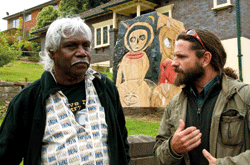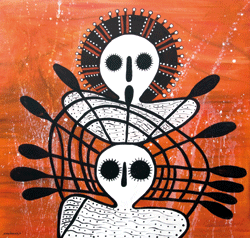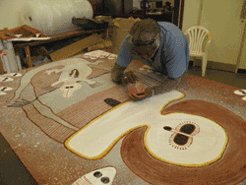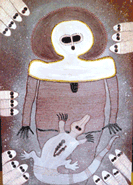
Safeguarding Cultural Heritage - The Case of the Sacred Wandjina
Delwyn Everard, Senior Solicitor at the Arts Law Centre of Australia discusses the challenges aboriginal communities face in protecting their cultural heritage.
About two meters tall and covered with crudely drawn representations of Aboriginal spirit figures, it sits on the verge of a property in Katoomba in Australia's World Heritage-listed Blue Mountains area. Local Aboriginal residents are disturbed by its presence. Over 4,000 kilometers away in Western Australia, the Worrora, Wunumbal and Ngarinyin Aboriginal nations are distressed and angry at its ongoing public display. Katoomba's nonindigenous community is divided over whether it is art or sacrilege.
The source of this controversy is a work of art created by a nonindigenous artist, on commission for a nonindigenous gallery and business, which has been outspoken in its criticism of Australia's Aboriginal people. The spirit figures depicted on the sculpture are Wandjina, a fact confirmed by the work's title “Wandjina Watchers in the Whispering Stone”.

Kimberley elder Donny Woolagoodja and local Darug
man Chris Tobin in front of the Katoomba sculpture by
a nonindigenous artist which is at the heart of the
controversy (Photo: Reinier Van de Ruit).
The Worrora, Wunumbal and Ngarinyin Aboriginal people of the remote Kimberley region have been painting Wandjina images for many thousands of years, at sacred rock sites and in caves, on dance totems and bark, and now on canvas and paper. The Wandjina is their supreme creator, the maker of the earth and all upon it. They are recognized as the only Aboriginal nations entitled to depict the Wandjina, a right respected by all other Aboriginal groups. That explains the discomfort of the Blue Mountains Darug people, who respect the cultural totems and laws of the Kimberley nations and are themselves shamed by this blatant disregard of indigenous culture occurring on their traditional lands. Anthropologist and Emeritus Professor Valda Blundell observes:
"Depicting Wandjina is a significant way in which Wandjina-Wunggurr people enact their identity as a distinct Aboriginal society and convey this identity to other Aboriginal societies as well as the non-Aboriginal world ...
The execution and public display of the Katoomba sculpture has not been authorized by Wandjina-Wunggurr people. Such an unauthorized portrayal of the Wandjina undermines the very foundation of their society in that it constitutes an attack on the specificity and integrity of their identity and the legitimacy of their cultural and religious beliefs. As an unauthorized depiction of Wandjina, it destabilizes the natural balance of their life-world which is only ensured when their laws and cultural protocols are followed."1
The legal issues are complex. The copyright law protecting contemporary individual creative expressions is unhelpful. It treats artwork by an artist who died more than 70 years ago as residing in the public domain and freely available for reproduction. The unknown artists responsible for the ancient and extraordinary rock art of the Kimberleys are long gone. The images on the Katoomba sculpture are not infringing copies of particular artworks by known artists. Rather they are instantly recognizable depictions (albeit distorted and lacking the elegance and power of genuine Wandjina) of the sacred spiritual imagery of a community within which the artist, and those who commissioned him, have no authority. This is an unauthorized misappropriation of an indigenous community's traditional culture and knowledge or indigenous cultural intellectual property (ICIP).
Article 31 of the Declaration on the Rights of Indigenous Peoples (DRIP), adopted by the General Assembly of the United Nations in 2007, reads as follows:
"1. Indigenous peoples have the right to maintain, control, protect and develop their cultural heritage, traditional knowledge and traditional cultural expressions, as well as the manifestations of their sciences, technologies and cultures, including human and genetic resources, seeds, medicines, knowledge of the properties of fauna and flora, oral traditions, literatures, designs, sports and traditional games and visual and performing arts. They also have the right to maintain, control, protect and develop their intellectual property over such cultural heritage, traditional knowledge, and traditional cultural expressions.
2. In conjunction with indigenous peoples, States shall take effective measures to recognize and protect the exercise of these rights.”

Artwork by Worrora artist Donny Woolagoodja
(Photo: Mowanjum).
While Australia declared its formal support for the Declaration in April 2009, it has since proven difficult to identify how Australian law protects the cultural rights involved. In 2010, when the Mowanjum Artists Spirit of the Wandjina Aboriginal Corporation (representing Worrora, Wunumbal and Ngarinyin artists) first approached the Arts Law Centre of Australia for assistance, it could not identify an obvious remedy. It was not only the sculpture that concerned Mowanjum. The gallery had also held an exhibition of paintings of Wandjina by nonindigenous artist Gina Sinozich entitled "Wandjina by Gina". As with the sculpture, many of the paintings showed Wandjina imagery incorporating mouths. This is particularly offensive to the traditional Aboriginal custodians. Wandjina are regarded as too powerful to be depicted with mouths as their power descends to Earth through the line seen as a nose. Gallery owner Vesna Tenodi had also published a book that was illustrated with the Sinozich images and espoused a thesis that the Australian indigenous peoples were a dying race suffering from spiritual atrophy2. That thesis, the book and the images were also promoted on the gallery's website.
Australia's Trade Practices Act 1974 3 prohibits misleading and deceptive conduct in the course of trade and commerce. Previously, it had been used to prosecute gallery owners selling art and artefacts purporting to be Australian Aboriginal art but which had, in fact, been created by nonindigenous artists4. The Arts Law Centre assisted Mowanjum in submitting a complaint to the Australian Competition and Consumer Commission (ACCC), the statutory body responsible for investigating breaches of the Act, on the basis that the exhibition of Wandjina paintings, the prominent public display of the sculpture outside the gallery, the statements and images on the gallery's website and the accompanying book all amounted to potentially misleading and deceptive conduct that was in breach of the Trade Practices Act, in that it falsely suggested an association with or license by one or more of the three Aboriginal nations and/or Mowanjum. Mowanjum argued that "such activities and the associated misrepresentations would be likely to confuse, mislead or deceive not only a substantial number of members of our organization (and its respective groups) but numerous other Aboriginal groups and others well familiar with our values and history, including non-Aboriginal people interested in our culture and the acquisition of genuine Wandjina artworks."5 The response was brief and disappointing. The ACCC determined that it "was unable to conclude that Ms. Tenodi has represented that she has permission to use the imagery, in circumstances where she may not need that permission."


Aboriginal artist Gordon Barung painting Coi Oi Wandjinas & Ungud and his completed
work (Photo: Joanna Wilkie, Mowanjum Art & Culture Centre).
The next step was to complain directly to the gallery owners. It was, however, becoming difficult to assert that the public would be confused or misled into thinking that these Wandjina images were sanctioned by the traditional custodians, as the controversy was receiving considerable media attention, making it very clear that Aboriginal groups were bitterly opposed to the gallery's actions6. While this focused attention on the dispute, it was a double-edged sword. Indeed, by now Ms. Tenodi's website carried numerous statements to the effect that she did not need permission from the traditional custodians, because she herself was in direct communication with the Wandjina spirits who supported her actions:
"I have the right to do what I do, as given to me by the Those-who-Know, whom you also call Wandjinas … I do not speak for Aboriginal people. I speak for Wandjinas, to the Aboriginal people."
With neither copyright law nor trade practice law providing any relief, help emerged from a surprising quarter. It seemed the sculpture required development approval from the local government body. That process required the Blue Mountains City Council to consider, among other matters, the social impact of the sculpture's public display on the property verge. Fifteen submissions opposing the grant of development approval for the site of the sculpture were filed, including by the Arts Law Centre in its own name and by the Environmental Defenders Office on behalf of both Mowanjum and the Kimberley Aboriginal Law and Culture Centre. The Council's decision to exclude the sculpture from its grant of approval stated that:
"The sculpture contains an interpretation of sacred Aboriginal images that is offensive, disturbing or distressful to some members of Aboriginal and non-Aboriginal communities, including local representatives of those communities, as evidenced in public submissions, and consequently has an adverse social impact and is not in the public interest"7 .

The hoarding placed around the sculpture is being
removed after the decision of the Land and Environment
Court. The graffiti reflects the intensity of local feeling
generated by the issue. (Photo: Reinier Van de Ruit)
In February 2011, Mr. and Mrs. Tenodi appealed that decision to the Land and Environment Court. At the hearing, the Arts Law Centre argued that because the sculpture had been created and displayed in breach of the traditional laws of the Wandjina custodians and in defiance of the wishes of local traditional owners, its display in Katoomba was a public expression of racial, cultural and religious intolerance and, as such, had a substantial adverse social impact. Powerful and eloquent submissions were made by Gordon Smith Junior, a Ngarinyin man who travelled from the Kimberley region to represent his people and voice their concerns. On June 21, 2011, the Court upheld the Blue Mountains City Council's decision. The result is that the sculpture must be removed.
Ms. Tenodi has criticized the decision and the Arts Law Centre's role as an attack on freedom of artistic expression. The Arts Law Centre is a strong proponent of freedom of artistic and cultural expression and has lobbied against artistic censorship and stricter classification laws. However, fundamental freedoms are validated by rational limits which recognize that a balance must be sought where pursuit of one freedom is at the cost of another. For example, legitimate constraints are placed on freedom of expression by the laws of defamation, criminal laws relating to child pornography and laws concerning racial vilification. In our view, freedom of artistic expression should not be used to justify an indefensible misappropriation and denigration of indigenous culture.
This case highlights the difficulties Aboriginal communities face in upholding their cultural interests, and the challenges of translating political will into practical reality. Limited protection of ICIP is already available as an incident of existing laws – such as where the misuse of ICIP involves misleading conduct in trade or commerce, or copyright infringement. While there is as yet no express legislative protection for ICIP, the importance of protecting and preserving indigenous culture is a vital element of two of the government's current policy initiatives. As part of Australia's commitment to engage proactively with its human rights agenda, a National Human Rights Action Plan is currently being developed that expressly acknowledges the "important international principles" established by DRIP8. Equally encouraging is the government's recently released Discussion Paper on the development of a new National Cultural Policy for Australia, which sets as its first goal "to ensure that what the government supports – and how this support is provided – reflects the diversity of a 21st century Australia, and protects and supports indigenous culture."9 Well said.
_______________________________
1 Submission of Valda Blundell to the Land and Environment Court, April 27, 2011 (Blundell submission)
2 Tenodi, Dreamtime Set in Stone: The Truth about Australian Aborigines, Anan Press, 2010, page 116
3 Now the Australian Consumer Law.
4 Australian Competition and Consumer Commission v Nooravi, [2008] FCA 2021
5 Letter from Mowanjum to the ACCC dated May 10, 2010
6 For example, http://www.abc.net.au/rn/lawreport/stories/2010/2939168.htm
7 Record of Blue Mountains City Council Meeting, October 12, 2010, page 30
8 Consultation Draft Baseline Study for Australia's National Human Rights Action Plan, June 2011, page 20
9 National Cultural Policy Discussion Paper, Department of the Prime Minister and Cabinet, 2011, page 14
The WIPO Magazine is intended to help broaden public understanding of intellectual property and of WIPO’s work, and is not an official document of WIPO. The designations employed and the presentation of material throughout this publication do not imply the expression of any opinion whatsoever on the part of WIPO concerning the legal status of any country, territory or area or of its authorities, or concerning the delimitation of its frontiers or boundaries. This publication is not intended to reflect the views of the Member States or the WIPO Secretariat. The mention of specific companies or products of manufacturers does not imply that they are endorsed or recommended by WIPO in preference to others of a similar nature that are not mentioned.